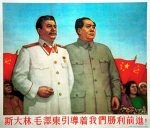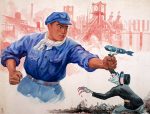
In October 1949 Mao Zedong and his followers declared victory in the Chinese Revolution and proclaimed the formation of the People’s Republic of China. With more than a half billion people, China replaced the Soviet Union as the world’s most populous socialist state. By rights, the People’s Republic and Soviet Russia should have been close allies for the duration of the Cold War. Both shared large populations, a commitment to Marxist socialism, turbulent revolutions and difficult transitions into socialism. Both were also surrounded and confronted by Western opposition and military alliances (NATO in Europe, SEATO in the Asia-Pacific). Despite these similarities, the relationship between communist China and the Soviet Union was complex and changeable. In the 1960s the two powers began to drift apart – and by late 1968 they had reached the brink of war. The Sino-Soviet split, as it became known, was a critical development in the Cold War.
The links between Chinese and Russian communists dated back to 1919 and the formation of the Communist International, or Comintern. This Moscow-based agency was formed to promote, support and offer guidance to socialist revolutionaries around the world. The Comintern played an important role in the formation and direction of the Chinese Communist Party (CCP). In line with Marxist theory, most members of the Comintern believed that China was not yet ready for socialist revolution. During the 1920s the CCP’s organisation, ideology and methodology followed instructions and advice from Moscow. When Mao Zedong gained control of the CCP in the mid-1930s he rejected the Comintern view, arguing that China was ready for a socialist revolution driven by the peasantry. The rise of Mao and his ideology of ‘peasant socialism’ formed the seeds of division between Chinese communists and the Soviet Union.

When Mao Zedong seized control of China in 1949, socialist regimes held power across one fifth of the globe and ruled a combined population of almost 800 million people. A friendly and productive relationship between Moscow and Beijing was considered vital for the advancement of world socialism. In late 1949 Mao travelled to Moscow to meet Joseph Stalin for the first time. Recognising the need for unity, Stalin and Mao signed a bilateral treaty called the Treaty of Friendship, Alliance and Mutual Assistance. It included a military alliance that required one to come to the other’s aid if they were attacked. More important to China were the treaty’s economic benefits, including a $300 million loan and the provision of Soviet technical advisors. During the 1950s thousands of scientists, industry experts and technicians from the Soviet Union lived and worked in China. Their advice and leadership played an important role in the industrialisation of China. Using the advice of Soviet economic strategists, Beijing committed itself to Stalinist models of development, growth and agricultural collectivisation.
Yet despite this successful collaboration, there were also signs of strain. Mao’s 1949 visit to Russia negotiated a successful treaty – but privately Mao felt undervalued and disrespected. The Chinese leader believed that Stalin had treated him as an underling rather than an important partner. In mid-1950, Mao committed forces to the Korean War, believing that Stalin would follow suit and commit Soviet forces and provide men, machinery and weapons. Stalin, however, preferred not to be drawn into an open conflict with the United States. He confined Soviet involvement in Korea to providing air support and supplying aircraft, weapons and munitions (for which he charged Mao’s government full price). The Korean War was politically successful for the Chinese but the costs to its struggling economy were enormous. Mao felt exploited and betrayed by Stalin, who had failed to honour his earlier assurances.

After Stalin’s death in 1953 Mao began to imagine himself as the world’s senior communist leader. In the Soviet Union leadership passed to Nikita Khrushchev, a party official who had previously shown unflinching loyalty to Stalin. This changed in February 1956 when Khrushchev delivered his famous ‘Secret Speech‘, in which he condemned the personality cult, despotism, show trials, purges and violence that occurred under Stalinism. Khrushchev’s criticism of Stalin placed Mao in an awkward position. While Mao distrusted Stalin in private, in public he had always praised Stalin is a brilliant socialist leader. Mao had also replicated Stalin’s cult of personality within China. For Mao, Khrushchev’s ‘Secret Speech’ was a betrayal of Stalin’s legacy. Chinese communists responded by developing their own interpretation of Stalin, which was articulated in the People’s Daily on April 5th 1956:
“Some people consider that Stalin was wrong in everything. This is a grave misconception. Stalin was a great Marxist-Leninist yet at the same time a Marxist-Leninist who committed several gross errors without realizing that they were errors. We should view Stalin from a historical standpoint, make a proper and all-round analysis to see where he was right and where he was wrong and draw useful lessons therefrom. Both the things he did right and the things he did wrong were phenomena of the international communist movement and bore the imprint of the times. Taken as a whole the international communist movement is only a little over 100 years old and it is only 39 years since the victory of the October Revolution… Great achievements have been made, but there are still shortcomings and mistakes.”

In October 1957 the Soviet Union and China signed a new defence accord, Moscow agreeing to share new military technologies including nuclear weapons prototypes. Sino-Soviet relations began to deteriorate shortly after, in part because of Khrushchev’s softer line toward the West. While Mao had always attacked the United States as an imperialist bully to be feared and resisted, Khrushchev suggested that “peaceful coexistence” with the US was possible. Khrushchev visited China in July 1958 but the meeting did not go well. The Soviet leader and his entourage were housed in dilapidated apartments without air conditioning, despite the sweltering heat. During the talks, Mao treated Khrushchev with arrogance and disdain – not dissimilar to how Mao had been treated by Stalin in 1949. Mao refused to consider Khrushchev’s proposed joint defence projects; Khrushchev retaliated by pulling the majority of Soviet advisors out of China. Khrushchev visited China again the following year and infuriated Mao with a speech that praised US president Dwight Eisenhower and his foreign policy. This particular trip was so acrimonious that it was trimmed from seven days to just three.
“The collapse of the Sino-Soviet alliance marked the transformation of the Cold War world from bipolarity to multipolarity… From its inception, the seemingly monolithic union was fraught with constantly shifting expectations about its precise place in the socialist world, subjected to American attempts to split it, and afflicted by the ideological radicalism of… Mao Zedong.”
Lorenz M. Luthi, historian
Moscow began to repudiate terms of the 1949 military alliance and within a year the Treaty of Friendship, Alliance and Mutual Assistance was all but dead. In 1960 the Soviet Union pulled its remaining technical advisors out of China, leaving several major infrastructure projects unfinished. The war of words continued, including verbal clashes between Chinese and Russian delegates at party conferences in 1960 and 1961. In 1962, following the Cuban missile crisis, Mao accused Khrushchev of being afraid of the United States. When China and India went to war briefly in late 1962 over disputed borders, Moscow threw its support behind India. By this time China and the Soviet Union were engaged in a cold war of their own, however, relations continued to worsen. In 1964 Mao Zedong claimed the Soviet Union still possessed Chinese territory stolen by pre-revolutionary Russia. In July 1964 he withdrew China’s ambassador and cut diplomatic ties with Moscow. Anti-Soviet propaganda inside China reached fever pitch. In August 1967, at the height of the Cultural Revolution, some 200,000 Red Guards, whipped into a frenzy by Mao’s anti-Soviet rhetoric, laid siege to the Soviet embassy in Beijing.
The Sino-Soviet came to a head with a brief border war in the late 1960s. Arguments over a contested border in Xinjiang province in north-western China led to a round of Sino-Soviet talks, however, these quickly broke down. In the summer and autumn of 1968 both the Chinese and Soviets increased their military presence in the region. Eventually, more than 1.5 million soldiers were housed on both sides of the Ussuri River. In October 1968 Chinese defence minister Lin Biao claimed that his forces were preparing for an invasion of Soviet territory. The first skirmishes were reported in March 1969, with Chinese and Russian soldiers firing at each other on Zhenbao Island. More clashes followed, forcing the resumption of talks in June. Between 350 and 700 soldiers were killed in the sporadic fighting in Xinjiang, most of them Chinese. For a time Soviet commanders even considered using tactical nuclear weapons against its former ally. The death of Vietnamese communist leader Ho Chi Minh in September 1969 facilitated the restoration of diplomatic contact, though Sino-Soviet relations remained frosty.

1. Sino-Soviet cooperation began with the formation of the Soviet Union and the Moscow Comintern, which provided support and direction for the fledgeling Chinese Communist Party (CCP).
2. In late 1949 Mao visited Stalin in Moscow. While Mao felt undervalued and disregarded by Stalin, the two leaders signed an important treaty and military alliance.
3. In public Mao and CCP propaganda hailed Stalin as a visionary leader of world socialism, however, in private Mao felt betrayed by Stalin’s lack of support and involvement during the Korean War.
4. In 1956 Nikita Khrushchev denounced the brutality that occurred under Stalin’s leadership. This condemnation of Stalin placed Mao in an awkward position and forced the CCP to reevaluate its position on Stalin.
5. Sino-Soviet relations continued to worsen from 1957, driven by ideological divisions, different attitudes to the West, provocative and hostile remarks, failed talks between Mao and Khrushchev, and border disputes that led to a brief conflict in 1969.
© Alpha History 2018-23. Content on this page may not be republished or distributed without permission. For more information please refer to our Terms of Use.
This page was written by Glenn Kucha, Jennifer Llewellyn and Steve Thompson. To reference this page, use the following citation:
G. Kucha et al, “The Sino-Soviet split”, Alpha History, accessed [today’s date], https://alphahistory.com/coldwar/sino-soviet-split/.
